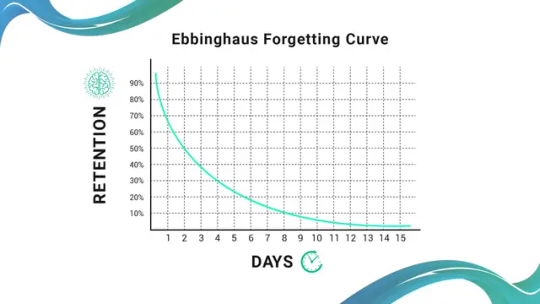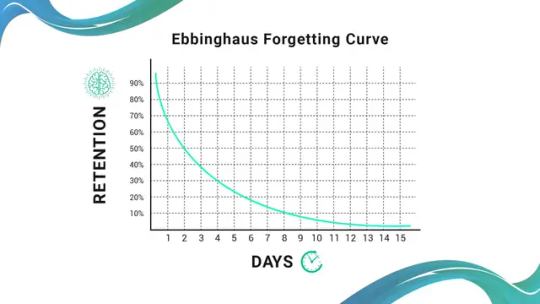#the curve of forgetting
Explore tagged Tumblr posts
Text
The Science of Forgetting: Why Trainers Must Rethink Learning Strategies

The Forgetting Curve and Its Relevance for Trainers: How to Ensure Long-Term Knowledge Retention
Introduction
Have you ever attended a training session, felt confident about what you learned, and then struggled to recall most of it just days later? This phenomenon is explained by the Forgetting Curve, a concept introduced by German psychologist Hermann Ebbinghaus in the late 19th century. His research showed that without reinforcement, people forget nearly 50% of newly learned information within an hour and up to 90% within a week.
For trainers, this presents a major challenge. No matter how well-designed a training program is, its effectiveness is limited if learners quickly forget the material. The good news? With the right strategies, trainers can combat the Forgetting Curve and ensure long-term knowledge retention.
This article explores the science behind the Forgetting Curve, its implications for trainers, and proven strategies to make learning stick.
Understanding the Forgetting Curve
What is the Forgetting Curve?
The Forgetting Curve describes how memory retention declines over time without reinforcement. Ebbinghaus conducted experiments where he memorized nonsense syllables and tested his recall over varying time intervals. His results formed a steep, downward-sloping curve, demonstrating rapid forgetting unless information is reviewed periodically.
Key Insights from the Forgetting Curve
Forgetting Happens Fast – Learners forget up to 70% of information within 24 hours of learning if there’s no reinforcement.
Repetition Strengthens Memory – Regular review interrupts forgetting and moves knowledge into long-term memory.
Meaningful Learning Improves Retention – Information that is relevant, contextual, and engaging is remembered better.
Active Recall is More Effective – Actively retrieving information (e.g., quizzes, teaching others) improves memory more than passive review.
These findings highlight the urgent need for trainers to implement strategies that reinforce learning over time.
Why the Forgetting Curve Matters for Trainers
For corporate trainers, L&D professionals, and educators, understanding the Forgetting Curve is critical. If trainees forget most of what they learn, then training programs are failing to create lasting impact.
Common Training Pitfalls That Lead to Forgetting
One-and-Done Training – Single-session workshops without follow-up lead to rapid information loss.
Overloading Learners – Dumping too much content at once overwhelms learners, making retention difficult.
Lack of Reinforcement – Without periodic reviews, knowledge fades quickly from memory.
Passive Learning Methods – Traditional lectures and static e-learning do not engage learners enough for deep retention.
The Cost of Forgetting in Organizations
Reduced Employee Performance – Employees forget essential skills, leading to mistakes and inefficiency.
Compliance Risks – Forgetting critical compliance regulations can result in legal consequences.
Wasted Training Investments – Organizations spend millions on training programs, but without reinforcement, much of that investment is lost to forgetting.
To overcome these challenges, trainers must design learning experiences that actively combat the Forgetting Curve.
How Trainers Can Overcome the Forgetting Curve
1. Use Spaced Repetition
Spaced repetition involves reviewing information at increasing intervals to strengthen memory. Instead of cramming, learners revisit key concepts multiple times over days, weeks, or months.
How to Implement Spaced Repetition
Microlearning Modules – Deliver bite-sized lessons with follow-up reinforcement.
Automated Learning Reminders – Use AI-powered learning platforms to schedule personalized review sessions.
Reinforcement Emails & Notifications – Send learners periodic reminders or quizzes.
Example: Instead of a one-time compliance training session, provide weekly microlearning refreshers on key policies.
2. Leverage Microlearning
Microlearning platform delivers small, focused lessons that are easier to digest and remember. Studies show that microlearning can increase retention by up to 50% compared to traditional training.
How Microlearning Helps Combat Forgetting
✅ Short & Focused – Learners absorb one concept at a time, improving retention. ✅ Flexible & On-Demand – Employees can access learning when they need it, reinforcing knowledge in real time. ✅ Engaging Formats – Videos, infographics, quizzes, and interactive lessons enhance engagement.
Example: Instead of a 3-hour training session, break it into 10-minute modules with real-world applications.
3. Implement Active Learning Techniques
Passive learning (reading, watching videos) leads to high forgetting rates. Active learning, which requires learners to engage, recall, and apply knowledge, significantly boosts retention.
Active Learning Strategies for Trainers
Quizzes & Retrieval Practice – Asking learners to recall information improves memory retention.
Scenario-Based Learning – Present real-world problems that require critical thinking and decision-making.
Peer Teaching – Encourage employees to teach concepts to others, reinforcing their understanding.
Gamification – Use leaderboards, challenges, and rewards to make learning engaging.
Example: After a training module on data security, give learners a real-world phishing attack scenario to solve.
4. Use AI-Powered Adaptive Learning
Artificial intelligence (AI) can personalize learning paths, ensuring that employees receive reinforcement exactly when they need it. AI analyzes learner performance and automatically adjusts training schedules to prevent forgetting.
How AI Helps Combat Forgetting
🚀 Personalized Reminders – AI identifies knowledge gaps and pushes targeted microlearning content. 🚀 Smart Adaptive Quizzes – AI-driven assessments help learners actively recall weak areas. 🚀 Just-in-Time Learning – Employees can access training at the moment of need for maximum retention.
Example: If an employee struggles with safety protocols, AI sends personalized refresher lessons.
5. Reinforce Learning with Real-World Application
Retention improves when learners apply knowledge in real-world scenarios. Trainers should create opportunities for hands-on practice and real-life implementation.
Ways to Reinforce Learning
On-the-Job Training Assignments – Give employees tasks that require applying new skills.
Role-Playing Exercises – Simulate real situations to deepen understanding.
Follow-Up Discussions & Coaching – Encourage knowledge sharing among peers.
Example: After a leadership training session, assign managers real coaching tasks to apply new skills.
Final Thoughts
The Forgetting Curve poses a significant challenge for trainers, but strategic learning reinforcement can dramatically improve retention. By incorporating spaced repetition, microlearning, active learning, AI-powered tools, and real-world application, trainers can ensure knowledge sticks—leading to more effective training programs and improved workforce performance.
🔹 Key Takeaways for Trainers: ✅ Combat forgetting with spaced learning & microlearning. ✅ Use active learning techniques like quizzes and real-world practice. ✅ Leverage AI-powered learning for personalized reinforcement. ✅ Reinforce learning with on-the-job application.
By shifting from one-time training events to continuous, reinforced learning, trainers can defeat the Forgetting Curve and maximize learning impact.
🚀 Want to improve your training programs? Explore how AI-powered microlearning solutions like MaxLearn can help!
#how to beat the forgetting curve#overcoming the forgetting curve#what is the forgetting curve#forgetting curve theory#the forgetting curve#curve of forgetting definition#curve of forgetting study method#according to ebbinghaus forgetting curve forgetting#memory curve#using forgetting curve#the curve of forgetting#ebbinghaus forgetting curve percentage#memory retention and the forgetting curve#forgetting curve psychology#forgetting curve study schedule#ebbinghaus retention curve#how to overcome forgetting curve#the ebbinghaus forgetting curve shows that:#forget curve#ebbinghaus curve of forgetting#curve of forgetting#what is ebbinghaus forgetting curve#how to overcome the forgetting curve#rate of forgetting#forgetting curve#forgetting curve graph#typical forgetting curve#forgetting curve calculator#what is the curve of forgetting#the ebbinghaus forgetting curve shows that
0 notes
Text
dean doing the clothes shopping whenever sammy outgrows whatever he’s got. he lurks around the local walmart, putting the charm on heavy when the lady stocking shelves looks his way.
he sneaks a set of girls underwear into his jacket, carries on like normal, and when he gets back to the motel-of-the-week and tosses them onto the bed, sammy mumbles a thanks with rosy cheeks and thumbs the fabric, soft to the touch.
dean’s been buying sam girls underwear since he graduated from pull-ups, claimed they were always the easiest to sneak out of the package and hide, stuff in his pocket—smaller, thinner, less bulky.
and all of that’s true, but dean can’t deny the gut churning thrill that crawls up his ribs whenever sammy’s shirt rucks up at the hem and he can see that pink trim dotted with that cute little bow, taut over his hips. can’t deny the way his stare lingers, chases the waistband over his stomach, across a hipbone, eyes stuck right beneath the dimples at the base of his spine. it’s maddening, how bad he wants to rip at those ratty sweatpants, yank them down and fill his hands with pretty pink and baby soft skin.
that night, it’s hot as all hell and the ceiling fans broken, dad’s out at a bar and they can’t sleep. sammy’s frustrated, sweaty and exhausted. and dean’s heart flips and nearly bursts on the spot when sammy shuffles off the side of the bed, pushes his shorts down those long legs and kicks them to the side.
and all at once there it is: his sammy, naked, save for those little pink panties dean eyed up in the store, slipped into his jacket, all for his baby brother.
sam climbs back into bed, flops onto his stomach and burys that messy bed head into the pillow. and god dean can barely control himself, wants to reach out and trace fingertips down the curve of his spine, dig blunt nails into the skin of his hips and drag, drag until he catches on that pink elastic.
#and maybe sam has no idea this isnt normal#never questions why dean and dad wear boxers and he doesnt just assumes deans got his best interest in mind#or maybe sam does know what deans been doing#and maybe he loves feeling those eyes all over him#maybe he lets his jeans hang low on his hips just to make sure dean will catch a glimpse#forgets his belt sometimes and has to keep tugging them up by the loops just for them to slip back down#and ride low just above the curve of his ass#pairs those jeans with a tight T because he knows how high the hem lays over his stomach#sam just loves being a tease for his big brother#loves putting on a show when he knows deans paying attention#loves knowing dean picked these out just for him#all so he can see his baby brother wrapped up like a present#anyways…#weecest#weirdcest#gencest#wincest#brothercest#deansam
198 notes
·
View notes
Note
I tried to draw sheep Machete and goat Vasco (but I am not good at drawing goats, at all)


.
#Macsheep and Goatsco#what do you mean I LOVE goat Vasco#the ears! the hejazi goat ears!#and his expression is just *chef's kiss* perfect#really captures that ungovernable goatlike glee#I like how he retained his smooth coat and sleek and curved shapes#and Machete looks very appropriate as a sheep as well#he would have even more reason to trim his neck wool as a sheep#come to think of it would he have to keep himself sheared at all times if he wanted his clothes to fit correctly?#and just keep the head fluff#I noticed that you paid attention to their snout shapes! sheep have kind of rabbitlike nose whereas goats have a smoother upper lip#with less prominent philtrum#I thought that was such a cool detail#something I often forget myself when I'm drawing these species#thank you!#gift art#arttsuka#Machete#Vasco#it's weird how much harder their expressions are to read solely because of the horizontal pupils#they're mammalian but lack that anthropomorphic familiarity I guess
957 notes
·
View notes
Text

@lemonm4ge got me into kevin spencer I HATE YOU I HATE YOU I HATE YOU
Thinking of making some kevin spencer inspired kandi
#kevin spencer#kevin spencer fanart#timmy mcnaughton#kandi#EMO AS HELL#I cant make fun of Timmy the extra stuff I added onto him is inspired by how i dress irl brooo#Im that one person in class that has piercings and wears 200 bracelets everyday#I dont think I look that emo but people love calling me that so maybe I rlly do look emo#its ok because people say im one of the “cool emos” which is nice#I need more belts#thats gonna have to wait though cuz im boutta blow round 60 dollars on tamagotchis#sometimes when im drawing i'll forget im allowed to draw curves in my lines and i'll make everything look really sharp and crispy#kevin looks really stupid in here im orry guys
100 notes
·
View notes
Text
anyone else start a new script and immediately forget how u do literally everything. started a new script and i forgot if i write scenarios in 1st person or not. OF COURSE I WRITE IN 1ST PERSON ohhhh my goddddd
#i feel so dumb sometimes#it’s a learning curve every time#and i can write scenarios on a more filled out script easy every time#what is it w new scripts and forgetting my routines#bro#🖤 slenderspeaks ⊗#shiftblr#reality shifting#shifting antis dni#shifting community#shifting realities#shifting#shifting script#shifters#shifting blog
63 notes
·
View notes
Note
do you think boyfriends/girlfriends always need to reply to texts/calls within 24 hours
No I think people get busy and that’s okay. However something I learned last year is if you’re like consistently struggling w keeping up w people, or they’re consistently struggling w meaningfully keeping up w you, it doesn’t mean they don’t like you or there’s a moral failure on their end so much as it means something is preventing either of u from fully committing to the relationship (platonic romantic whatevs)… and that that’s something to investigate bc what’s preventing u?
It could be that they’re not into you, that they’re busy, that they’re going through something etc etc and honestly the only people who’ll know are the people in that actual relationship so trust your gut and try to make an informed choice and be okay w the consequences
#Also other people are valid to get fed up w it but therapy speak culture is very rampant rn and a lot of times#People don’t push themselves enough to show the ppl they love they love them#Or they don’t give people who’re struggling grace#I’m not a saint so I’ve been on the receiving and giving end of that#Also if your choice is to let go you have to be okay w people forgetting about you#Which actually is the case for me and a massive learning curve rn
47 notes
·
View notes
Text
sometimes i forget that people genuinely perceive season four sam exorcising demons w his powers as genuinely horrible, or even scale his killing the nurse in 4.22 as the worst he's ever done. on the 4.04, "use the knife!" and [proceeds to use the demon blade and angel blade for seasons upon season afterward] and drains multiple people in 5.21 and 7.15 flashback scene show
#kindergarten concept to me. like can we be fr lmfao#tbh soulless!sam has done 'worse' than sesson four sam and sam still managed to take responsibility for it AS figuring out what happened#i genuinely really do forget that people interpret the show from this level of dissonant narrative framing#even sam's letting lucifer out of the cage was highly manufactured (both in terms of the actual event + sam's consent)#like i get it people who think of the show this way could care less since they're not actually interested in sam much less#this hypocritical view of him at all but like even if you believe in the dichotomy of monstrosity they show you sam saving lives#+ his motivations within that season. even his drinking of the blood was consensual and was even attempted to be forced onto him#in specific instances so your dislike of it mainly just comes down to your dislike of the imagery or idea of it#which is shallow as hell at best and negligent of sam's 'supernatural' circumstance as a character at worst#also re: theo's tags the 'well. he was killing innocent people' as if the whole reason he was doing in the first place wasn't#because he curved that !! he says it at the end of 4.01 and again in 4.04 he was saving people with 'this curse' and he was proud of that#he literally‚ on screen‚ within canon events‚ was doing the Opposite of killing innocent people and the ways#in which he did kill innocent people were typical monster kills on the monster hunting show#&#referat
47 notes
·
View notes
Text

#“is he under water or in space?”#well wouldn't YOU like to know weatherboy#<< sorry that vine has been in my head all day and y'all are my outlet#so my goal for the year was to get more confident with colors#i think i'm getting there#this *does* have a tone curve on it but i didn't adjust much so i'm considering that a win#just wanted to bring back some of the teal tones i lost while rendering#closing requests sometime tonight btw!#i'll do it whenever i go to bed#so that could mean in one hour or in five (because what's a sleep schedule)#ralsei#deltarune#ralsei in places that don't exist in actual deltarune#update; let's all pretend that i didn't forget to draw his horns
77 notes
·
View notes
Text
The Forgetting Curve in Action: Why Traditional Training Fails and How to Fix It

The Forgetting Curve and Its Relevance for Trainers: How to Maximize Knowledge Retention
Introduction
One of the biggest challenges trainers and learning professionals face is ensuring that employees retain and apply what they learn. The Forgetting Curve, a concept introduced by German psychologist Hermann Ebbinghaus, highlights a harsh reality: people forget nearly 50% of newly learned information within an hour and up to 90% within a week if the learning is not reinforced.
This article explores the impact of the Forgetting Curve on corporate training and presents science-backed strategies to help trainers design programs that enhance retention and performance.
Understanding the Forgetting Curve
The Forgetting Curve visually represents the decline of memory retention over time. The steep drop in recall occurs because the brain prioritizes information it deems useful and discards the rest.
Why Does the Forgetting Curve Happen?
🔹 Lack of reinforcement – Without reviewing or applying knowledge, learners forget it quickly. 🔹 Information overload – Employees often receive too much content in a short time, making it difficult to retain. 🔹 Passive learning methods – Traditional lecture-based training lacks engagement, leading to lower retention. 🔹 No real-world application – If employees don’t apply what they learn, the brain doesn’t encode it as important.
The Impact of the Forgetting Curve on Training Programs
For trainers and L&D teams, the Forgetting Curve has serious implications:
🚨 Wasted Training Investment – Organizations spend millions on training programs, but if learners forget most of the content, ROI plummets. 🚨 Decreased Employee Performance – When employees can’t retain critical information, errors increase, and productivity suffers. 🚨 Compliance & Safety Risks – Forgetting key policies and procedures can lead to regulatory violations and safety hazards.
So, How Can Trainers Combat the Forgetting Curve?
To ensure long-term knowledge retention, trainers need to rethink how they deliver learning. The key lies in reinforcement, engagement, and personalization.
5 Proven Strategies to Overcome the Forgetting Curve
1. Implement Microlearning for Continuous Reinforcement
Microlearning—delivering short, focused learning modules—perfectly aligns with how the brain retains information. Instead of overwhelming employees with long training sessions, microlearning delivers content in small, digestible chunks over time.
✅ Why it works: Spaced, bite-sized learning strengthens memory recall and helps employees retain knowledge better. ✅ How to implement:
Use AI-powered microlearning platforms like MaxLearn to break down training into 2-5 minute lessons.
Deliver content in multiple formats, such as short videos, interactive quizzes, and infographics.
Ensure learners revisit key concepts at spaced intervals to reinforce knowledge.
2. Use Spaced Repetition to Strengthen Retention
Spaced repetition is a scientifically proven technique that involves reviewing learning material at increasing intervals over time. This resets the Forgetting Curve, reinforcing memory before it declines.
✅ Why it works: Helps the brain move information from short-term to long-term memory. ✅ How to implement:
Schedule follow-up quizzes at 1 day, 7 days, and 30 days after the initial training.
Use AI-driven adaptive learning to personalize review schedules based on individual performance.
Send automated knowledge reinforcement nudges via mobile apps or email.
3. Make Learning Interactive & Engaging
Active learning significantly improves retention compared to passive learning. Gamification, interactive content, and real-world scenarios keep learners engaged and improve recall.
✅ Why it works: Active participation improves focus, motivation, and knowledge application. ✅ How to implement:
Use gamified learning platforms with quizzes, badges, and leaderboards.
Create scenario-based simulations where employees practice real-world situations.
Encourage peer learning and collaboration through discussion forums or group challenges.
4. Leverage AI-Powered Adaptive Learning
AI-driven learning platforms can analyze learner behavior and deliver personalized reinforcement based on knowledge gaps.
✅ Why it works: AI ensures learners receive targeted support exactly when they need it. ✅ How to implement:
Use an AI-powered LMS like MaxLearn to track learner progress and adjust content dynamically.
Deliver automated quizzes that adapt in difficulty based on the learner’s performance.
Provide AI-driven content recommendations to strengthen weak areas.
5. Integrate Learning into the Flow of Work
Employees learn best when training is embedded into their daily workflow rather than being a separate event.
✅ Why it works: Learning in context ensures immediate application, reinforcing memory. ✅ How to implement:
Provide on-demand microlearning resources accessible via mobile devices.
Integrate learning reminders into collaboration tools like Slack or Microsoft Teams.
Offer real-time performance support tools, such as chatbots and digital job aids.
Case Study: Beating the Forgetting Curve with MaxLearn
Companies using MaxLearn’s AI-powered microlearning platform have reported higher knowledge retention and training effectiveness. By leveraging spaced repetition, adaptive learning, and gamification, organizations have:
✔ Increased retention rates by up to 80% ✔ Reduced training time by 50% while improving results ✔ Boosted employee engagement and performance
Conclusion: Training That Sticks
The Forgetting Curve presents a significant challenge for trainers, but with the right strategies, it can be overcome. By implementing microlearning, spaced repetition, AI-driven personalization, and in-the-flow learning, trainers can ensure that knowledge sticks—leading to better performance, higher ROI, and long-term success.
Ready to Defeat the Forgetting Curve?
Explore MaxLearn’s AI-powered microlearning platform and transform your training today! 🚀
#how to beat the forgetting curve#overcoming the forgetting curve#what is the forgetting curve#forgetting curve theory#the forgetting curve#curve of forgetting definition#curve of forgetting study method#according to ebbinghaus forgetting curve forgetting#memory curve#using forgetting curve#the curve of forgetting#ebbinghaus forgetting curve percentage#memory retention and the forgetting curve#forgetting curve psychology#forgetting curve study schedule#ebbinghaus retention curve#how to overcome forgetting curve#the ebbinghaus forgetting curve shows that#forget curve#ebbinghaus curve of forgetting#curve of forgetting#what is ebbinghaus forgetting curve#how to overcome the forgetting curve#rate of forgetting#forgetting curve#forgetting curve graph#typical forgetting curve#forgetting curve calculator#what is the curve of forgetting#memory retention graph
0 notes
Note
hi !!! do you have photos of the curtains you made? I'm so curious...
ahhh i already hung them ;-; just imagine some really poorly hemmed sheer curtains in a set of 5. two bottom. two swags. one center upper piece 😭😭😭
i dont know how to sew curves very well so if anyone has any tips please give them to me please

thank you its tradition now i guess 😭😭
#ask#my sewing machine would get jammed and then id pull the jam out and forget to rethresd the needle#and i feel like everytime i did that the line on the curved part of the swag would be so good#😭😭
23 notes
·
View notes
Text


* revue starlights your togawa sakiko *
her weapon (the falchion) was originally named victoria blue while in crychic but was changed to oblivisci in ave mujica, and her revue cape is based on masquerades
#bandori#bang dream#revue starlight#ave mujica#sakiko togawa#togawa sakiko#mygo#sketchbook#OKAY SO UHHHH#the falchion is a curved sword weapon used to represent power and is consider a work of art and used primarily by commoners#and victoria blue is another name for forget me not#aka the flower#and oblivisci is the latin word for to forget#MAYBE ILL DRAW MORE#avemygo revstar au
187 notes
·
View notes
Text
I swear I did not animate this poorly on purpose. It is only intended as a WIP showcase, because I have yet to sleep but it is also 7 AM.
...anyways. ProwlRod stuff. :)
Song: Pretty Boy by Sub-Radio
[Prowl model by Pharaoh-Yami, Rodimus model by dancing-robots, both users are on DeviantArt]
#idw rodimus#idw prowl#prowlrod#once again: this is a wip. so the animation is Not Great#I will put more effort into making the movements and interpolation curve usage actually look good once I've slept adequately#I still have a bit more of the animation to get through too#hopefully this will be a lot better once I'm actually done. and i won't forget about it like i did with the ''repress it!'' animation#ask to tag
7 notes
·
View notes
Text
trying to learn picking and strumming so i can play electric guitar as god intended is gonna make me lose my mind its so frustrating. i started w fingerstyle acoustic so fingerstyle is all ik how to do on any guitar. i HATE picks
#ik theres just a learning curve same as when i started fingerstyle its just so long ago now that i forget#but god ITS SO FRUSTRATINGGGGGGG WHY AM I NOT INSTANTLY GOOD AT IT#it makes me consider buying like 1 or 2 guitar lessons just for someone to show me how to fucking hold a pick properly#x
8 notes
·
View notes
Note
Please god give me some ipod facts i NEED this
ok admittedly im not THAT insane abt ipods yet (but give me a month or two and i might be) but im kindasorta getting into collecting them so i wanna talk abt the little bit ive learned from that
i started out looking for gen 4 nanos bc i had an orange one as a kid (which i tried to get back from my parents but apparently they threw it away. rip) i wound up getting this listing for two ipods- one silver nano and one pink shuffle, bc they were dirt cheap overall BUT the seller v clearly didnt know anything abt ipods so it was a gamble
the nano worked! but only when plugged in cuz i guess the battery's too old. which is a shame bc it's otherwise in perfect condition, it's not even scratched anywhere. the shuffle worked even better, but it was pink and that's like the one color i didnt want an ipod in lmao. i named it breakfast bc it's pink and then i immediately got attached to it lmao
i wound up sending breakfast to packtion since they wanted to try an ipod too, and also bc i had ordered a second nano already dkfghk. this one works near perfectly (the hold switch is kinda busted but whatever) AND it's purple. which is my favorite color but it's also specifically my favorite ipod nano color bc depending on the lighting it can often look more blue than purple and i think that's a sick optical illusion. this one is named nova, and it's become my go-to for music listening now. i havent named the silver one bc im hoping i can sell it but nobody seems interested in my broken ass son sadly lol
anyway here's all 3 of them. family photo

ok now here's a fun fact for you since you read this far. apparently the ipod nano is like The Worst ipod to collect, especially gen 4 dkfhgk it's mostly because nanos are extremely hard to mod/repair given how small they are, so a lot of issues that can spring up w age aren't considered worth the effort to fix. this means if you have an ipod that's busted, it's an uphill battle to get it fixed, and also if you're searching for one online you have to keep an eye out for signs it might be broken. also since theyre so tiny if the battery inside swells even a tiny bit the screen starts getting fucked up bc it's already pressing against it lmao. sickly ass devices but theyre adorable so im gonna buy 80 more of them
#asks#the silver one came with a gray rubber case/skin thing so it looks more black#i tried putting it on nova yesterday but it looked dumb lol#the good news is a lot of ipods are fairly cheap#i got the first two for $23 total and nova for like $25 (not including shipping cuz idr how much it was)#it helps to look for older ones. but also theres a bell curve to it bc ofc the oldest ones are super coveted lol#but if youre like me who's a freak and prefers nano 4s and shuffles lmfao then youre in luck#from here id like to collect either a touch or maybe a classic? but both are significantly more expensive than nanos are#and i also kinda want a second shuffle just bc i rly love the clip on it#being able to clip smth tiny to ur belt loop and basically forget about it after that is awesome#it's still wired headphones but it offers a similar free feeling to bluetooth bc you can just walk around phoneless#esp if the ipod is clipped onto you and isnt in a pocket bc its just On You its not encumbering you in any way#anyway . thats what ive been up to lmao#oh also if anyone wants my sickly victorian son dm me
12 notes
·
View notes
Text
The tragedy of knowing what's wrong with your art but not knowing how to fix it
#i know there's a learning curve but also my brain will beat me up if it's not perfect right away🫠#every time i try to art i forget how to art#ramble gamble
30 notes
·
View notes
Text
Breaking the Forgetting Curve: How Trainers Can Boost Knowledge Retention

Overcoming the Forgetting Curve: A Trainer’s Guide to Lasting Learning
The Forgetting Curve, introduced by German psychologist Hermann Ebbinghaus, reveals a harsh truth about learning: most of what we learn is quickly forgotten unless reinforced. For corporate trainers and L&D professionals, this presents a major challenge. How can organizations ensure that employees retain critical knowledge and skills?
This article explores the science behind the Forgetting Curve and offers practical, research-backed strategies to help trainers improve knowledge retention, ensuring that training investments lead to long-term performance improvements.
Understanding the Forgetting Curve
The Forgetting Curve illustrates how memory retention declines over time. According to Ebbinghaus, people forget nearly 50% of newly learned information within an hour, and up to 90% within a week—unless the information is reinforced.
This decline happens due to:
Lack of reinforcement – If new knowledge isn’t revisited, the brain deprioritizes it.
Information overload – Employees often receive too much training at once, making retention difficult.
Passive learning – Traditional one-time training sessions fail to engage learners actively.
Why the Forgetting Curve Matters for Trainers
The Forgetting Curve isn’t just a psychological theory—it has real-world implications for workplace training. If employees forget what they learn, organizations face:
✅ Lower training ROI – Wasted time and resources on ineffective training. ✅ Decreased productivity – Employees make mistakes due to forgotten information. ✅ Compliance risks – Critical safety or regulatory knowledge may be lost. ✅ Inconsistent performance – Knowledge gaps lead to inefficiency and errors.
To overcome these challenges, trainers must redesign learning experiences that promote retention.
How Trainers Can Overcome the Forgetting Curve
1. Reinforce Learning with Microlearning
Microlearning platform—delivering bite-sized, focused lessons—aligns perfectly with how our brains retain information. Instead of long training sessions, employees engage with short, interactive lessons over time.
🔹 Why it works: Microlearning enables spaced repetition, allowing learners to revisit concepts before they are forgotten. 🔹 How to implement:
Use AI-powered microlearning platforms like MaxLearn to personalize training.
Break down courses into 2–5 minute lessons for quick consumption.
Reinforce key concepts multiple times over weeks for better retention.
2. Apply the Spaced Repetition Technique
Spaced repetition is a scientifically proven technique that strengthens memory. Instead of cramming all learning in one session, information is revisited at strategic intervals to reset the Forgetting Curve.
🔹 Why it works: Regular exposure strengthens neural pathways, leading to long-term retention. 🔹 How to implement:
Schedule follow-up quizzes or refresher sessions at 1 day, 7 days, and 30 days after initial training.
Use AI-driven adaptive learning to personalize review sessions based on learner progress.
Implement gamified challenges to encourage engagement and recall.
3. Make Learning Interactive & Engaging
Active engagement increases retention rates by up to 90% compared to passive learning. Instead of traditional lectures, use gamification, simulations, and hands-on activities.
🔹 Why it works: The brain retains information better when learning is experiential and meaningful. 🔹 How to implement:
Integrate quizzes, leaderboards, and rewards in training sessions.
Use scenario-based learning to mimic real-world situations.
Encourage peer discussions and collaborative learning.
4. Leverage AI-Powered Adaptive Learning
AI can personalize training based on individual learning patterns, ensuring that employees receive reinforcement exactly when needed.
🔹 Why it works: AI analyzes learner progress and delivers personalized reinforcement, helping learners overcome weak areas. 🔹 How to implement:
Use an AI-powered learning management system (LMS) like MaxLearn to track learner progress.
Deliver tailored content recommendations based on knowledge gaps.
Automate adaptive quizzes that adjust difficulty based on performance.
5. Encourage Learning in the Flow of Work
Learning shouldn’t be a one-time event; it should be embedded into daily workflows. Employees should be able to access training when they need it most.
🔹 Why it works: Contextual learning ensures that employees apply knowledge immediately, strengthening retention. 🔹 How to implement:
Provide on-demand learning resources via mobile-friendly platforms.
Use microlearning nudges or daily learning prompts in collaboration tools like Slack or Microsoft Teams.
Offer real-time performance support with job aids, checklists, and AI chatbots.
Conclusion: Training that Sticks
The Forgetting Curve is a natural part of human cognition, but trainers can overcome it with the right strategies. By leveraging microlearning, spaced repetition, engagement, AI-driven personalization, and learning in the flow of work, organizations can ensure that training leads to long-term knowledge retention and improved performance.
With AI-powered platforms like MaxLearn, trainers can make learning smarter, more engaging, and retention-focused—leading to higher ROI and a more skilled workforce.
Want to defeat the Forgetting Curve? Implement microlearning-based training today! 🚀
#how to beat the forgetting curve#overcoming the forgetting curve#what is the forgetting curve#forgetting curve theory#the forgetting curve#curve of forgetting definition#curve of forgetting study method#according to ebbinghaus forgetting curve forgetting#memory curve#using forgetting curve#the curve of forgetting#ebbinghaus forgetting curve percentage#memory retention and the forgetting curve#forgetting curve psychology#forgetting curve study schedule#ebbinghaus retention curve#how to overcome forgetting curve#the ebbinghaus forgetting curve shows that#forget curve#ebbinghaus curve of forgetting#curve of forgetting#what is ebbinghaus forgetting curve#how to overcome the forgetting curve#rate of forgetting#forgetting curve#forgetting curve graph#typical forgetting curve#forgetting curve calculator#what is the curve of forgetting#memory retention graph
0 notes